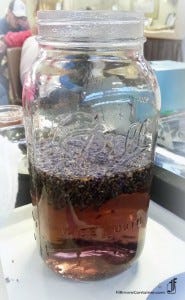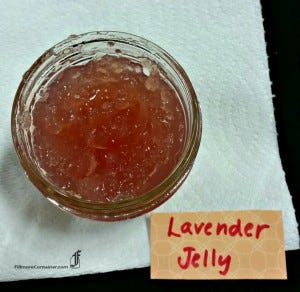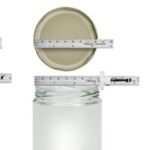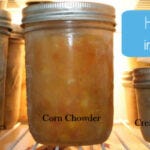
Lavender Jelly from Preserving with Pomona’s Pectin
We recently made our first batch of Lavender Jelly at the PA Farm Show, and boy was it good and so pretty!
Just like with most preserves, the quality of your starting products matters. A good quality culinary Lavender will result in a better flavor. Whenever possible, we try to source our ingredients from local or regional growers who exhibit strong sustainability practices. We were thrilled to find a Hope Hill Lavender Farm; a PA Preferred source for Lavender. A big thanks to them for letting us test out their culinary lavender buds.
Lavender Jelly
Excerpted from Preserving with Pomona’s Pectin by Allison Carroll Duffy (Fair Winds Press, June 2013).
This recipe is adapted from a recipe by jelly-maker Kelli Menzen of Crossroads Bakeshop in Doylestown, Pennsylvania, this delicious, complex jelly is a refreshing change of pace from other jellies in that it’s made from infused lavender water, rather than fruit juice. It’s not purple; rather, it’s a lovely golden brown. It is delightful on scones for afternoon tea. Lavender buds are available in the herb section of many natural food stores.
4 1/4 cups (1 L) hot (not boiling) water
1/2 cup (19 g) dried lavender buds
1/2 cup (120 ml) lemon juice
4 1/4 teaspoons (21 ml) calcium water*
1 3/4 cups (350 g) sugar
4 1/4 teaspoons (12.8 g) Pomona’s pectin powder
Before You Begin:
Prepare calcium water. To do this, combine ½ teaspoon calcium powder (in the small packet in your box of Pomona’s Pectin) with ½ cup water in a small, clear jar with a lid. Shake well. Extra calcium water should be stored in the refrigerator for future use. Never used Pomona’s our calcium water? Here’s a closer look at what calcium water is.
Calcium water is a solution of the monocalcium phosphate powder (food-grade rock mineral source) that comes in its own packet with every purchase of Pomona’s Pectin. The Pomona’s Pectin directions tell you how to make calcium water with the calcium powder. Pomona’s Pectin recipes call for calcium water because the pectin is activated by calcium, not by sugar. For more information about calcium water, please visit the FAQ page of the Pomona’s Pectin website.
 1. Prepare your jars, lids, and bands; heat up your canner; and sterilize your jars.
1. Prepare your jars, lids, and bands; heat up your canner; and sterilize your jars.
2. Place lavender buds in a heat-proof bowl and pour the 41/4 cups (1 L) hot (not boiling) water over them. Cover and allow to steep for 15 to 20 minutes.
NOTE: We steeped my lavender for 15 minutes, which resulted in a liquid that was not purple or lavender, but appeared more like your typical tea. However, when I added the lemon juice, the color suddenly changed to the airy pink hue you see in the jar.
3. Using a fine mesh strainer, drain and discard the lavender buds, reserving the infused liquid.
4. Measure 4 cups (946 ml) of the infused liquid (if necessary, add extra water to meet the required measurement) and combine in a saucepan with lemon juice and calcium water.
5. In a separate bowl, combine sugar and pectin powder. Mix thoroughly and set aside.
6. Bring infused lavender mixture to a full boil over high heat, and then slowly add pectin-sugar mixture, stirring constantly. Continue to stir vigorously for 1 to 2 minutes to dissolve pectin while the jelly comes back up to a boil. Once the jelly returns to a full boil, remove it from the heat.
7. Can Your Jelly: Remove jars from canner and ladle hot jelly into hot jars, leaving 1/4 inch (6 mm) of headspace. Remove trapped air bubbles, wipe rims with a damp cloth, put on lids and screw bands, and tighten to fingertip tight. Lower filled jars into canner, ensuring jars are not touching each other and are covered with at least 1 to 2 inches (2.5 to 5 cm) of water. Place lid on canner, return to a rolling boil, and process for 10 minutes (adjusting for altitude if necessary). Turn off heat and allow canner to sit untouched for 5 minutes, then remove jars and allow to cool undisturbed for 12 to 24 hours. Confirm that jars have sealed, then store properly.
Yield: 4 to 5 half-pint (8-ounce, or 236 ml) jars






Looks like this jelly has the same problem I have had with other low sugar jellies – the texture looks lumpy. Texture is important to me, so I am now using traditional pectin most of the time.
Actually, I was quite pleased with this jelly. This was setting out for sampling, so passers by were scooping it up with pretzels. 🙂